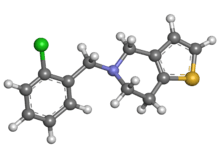Ticlopidine
 | |
|---|---|
 | |
| Systematic (IUPAC) name | |
| 5-(2-chlorobenzyl)-4,5,6,7-tetrahydrothieno[3,2-c]pyridine | |
| Clinical data | |
| Trade names | Ticlid |
| AHFS/Drugs.com | monograph |
| MedlinePlus | a695036 |
| Pregnancy cat. | B1 (AU) C (US) |
| Legal status | ? |
| Routes | Oral |
| Pharmacokinetic data | |
| Bioavailability | >80% |
| Protein binding | 98% |
| Metabolism | Hepatic |
| Half-life | *12 hours (single dose) |
| Excretion | Renal and fecal |
| Identifiers | |
| CAS number | 55142-85-3 |
| ATC code | B01AC05 |
| PubChem | CID 5472 |
| DrugBank | DB00208 |
| ChemSpider | 5273 |
| UNII | OM90ZUW7M1 |
| KEGG | D08594 |
| ChEBI | CHEBI:9588 |
| ChEMBL | CHEMBL833 |
| Chemical data | |
| Formula | C14H14ClNS |
| Mol. mass | 263.786 g/mol |
| SMILES
| |
| |
| | |
Ticlopidine (trade name Ticlid) is an antiplatelet drug in the thienopyridine family. Like the newer drug clopidogrel, it is an adenosine diphosphate (ADP) receptor inhibitor. It is used in patients in whom aspirin is not tolerated, or in whom dual antiplatelet therapy is desirable. Because it has been reported to increase the risk of thrombotic thrombocytopenic purpura (TTP) and neutropenia, its use has largely been supplanted by clopidogrel, which is thought to have a much lower hematologic risk. Its niche role as an alternative in those patients who do not tolerate clopidogrel was superseded by Ticagrelor and Prasugrel. The usual dose is 250 mg twice daily by the oral route.
Action
- Inhibits platelet aggregation by altering the function of platelet membranes by blocking ADP receptors. This prevents the conformational change of glycoprotein IIb/IIIa which allows platelet binding to fibrinogen.
- Prolongs bleeding time.
- Decreased incidence of stroke in high-risk patients.
Contraindications
- Hypersensitivity
- Bleeding disorders
- Active bleeding
- Severe liver disease
Precautions
- Risk of bleeding (trauma, surgery, history of peptic ulcer disease)
- Renal or hepatic impairment
- Geriatric patients (increased sensitivity)
- Pregnancy, lactation, or children under 18
- Neutropenia
- Thrombotic thrombocytopenic purpura
| |||||||||||||||||||||||||||||||||||||||||||||||||||||||